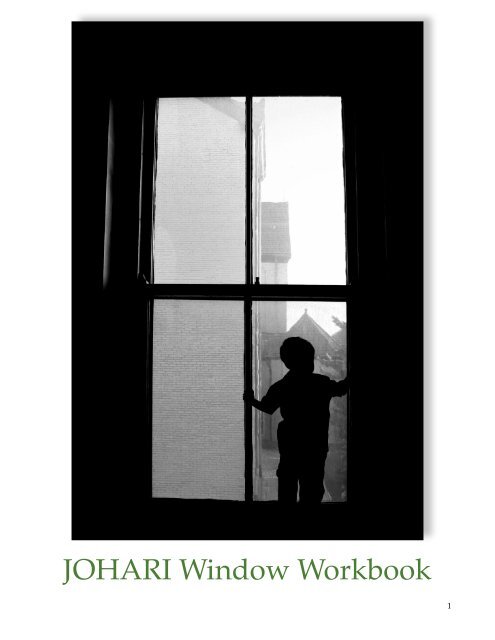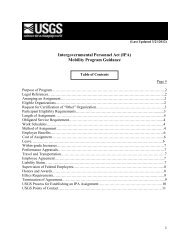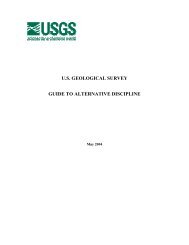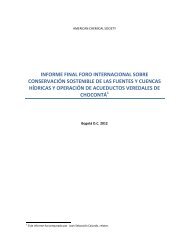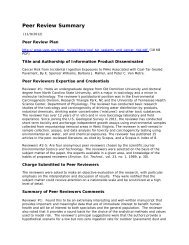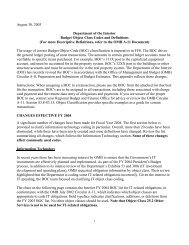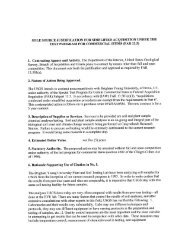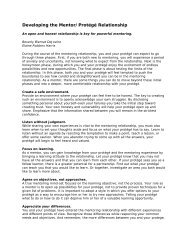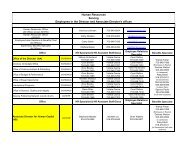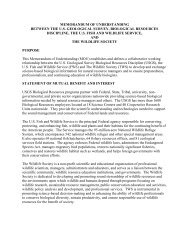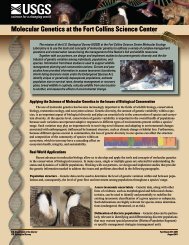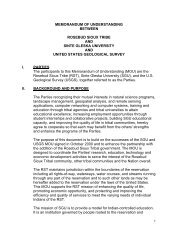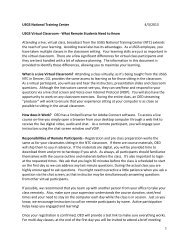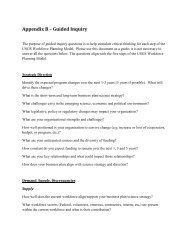JOHARI Window Workbook - the USGS
JOHARI Window Workbook - the USGS
JOHARI Window Workbook - the USGS
You also want an ePaper? Increase the reach of your titles
YUMPU automatically turns print PDFs into web optimized ePapers that Google loves.
<strong>JOHARI</strong> <strong>Window</strong> <strong>Workbook</strong><br />
1
<strong>JOHARI</strong> <strong>Window</strong><br />
Known to Self<br />
Not Known to Self<br />
Known to<br />
O<strong>the</strong>rs<br />
Open/Free Area<br />
Blind Area<br />
Not Known to<br />
O<strong>the</strong>rs<br />
Hidden Area<br />
Unknown Area<br />
The name, <strong>JOHARI</strong> <strong>Window</strong>, makes it sound like a complicated tool. In reality,<br />
Joseph Luft and Harrington Ingham created <strong>the</strong> memorable name for <strong>the</strong>ir model<br />
by combining <strong>the</strong>ir first names, Joe and Harry. It was first used in 1955 and since<br />
<strong>the</strong>n has become a widely used model for understanding and training in a<br />
variety of self-awareness dependent activities such as: personal development,<br />
communications, interpersonal relationships, group dynamics, team<br />
development and inter-group relationships.<br />
The <strong>JOHARI</strong> <strong>Window</strong> provides a useful format for representing personal and/or<br />
group information such as feelings, experiences, views, attitudes, skills,<br />
intentions, motivation, etc from four perspectives. The labels refer to 'self' and<br />
'o<strong>the</strong>rs': 'self' means oneself while 'o<strong>the</strong>rs' means o<strong>the</strong>r people in <strong>the</strong> person's<br />
group or team. It is an excellent tool for comparing self-perception to public<br />
perception and becoming a guide map developmental improvements.<br />
2
Known to Self<br />
Not Known to<br />
Self<br />
Known to<br />
O<strong>the</strong>rs<br />
Open/Free Area<br />
Blind Area<br />
Not Known to<br />
O<strong>the</strong>rs<br />
Hidden Area<br />
Unknown Area<br />
The Four Quadrants<br />
The Open/Free Area quadrant is also known as <strong>the</strong> 'area of free activity'. This is<br />
<strong>the</strong> behavioral and emotional information about <strong>the</strong> person is known by <strong>the</strong><br />
person ('<strong>the</strong> self') and o<strong>the</strong>r people. Examples of such information may include<br />
trust levels, communication style, competence at work and leadership<br />
effectiveness.<br />
In teams and working groups, a goal should be <strong>the</strong> development<br />
and expansion of <strong>the</strong> 'open area' for every person, because when<br />
this area is expanded, people are most effective and productive,<br />
and, consequently, so are teams and working groups. The Open/<br />
Free area, minimizes distortions and mistrust by providing<br />
opportunities for dialogue on topics that are openly acknowledged<br />
as important.<br />
The size of <strong>the</strong> Open/Free area is a developmental outcome of working<br />
relationships. People with established working relationships will have <strong>the</strong> lager<br />
areas and those who are new will have <strong>the</strong> smaller areas. The Open/Free area is<br />
usually expanded by encroaching into <strong>the</strong> Blind and Hidden areas. That means<br />
that <strong>the</strong> enlargement of <strong>the</strong> Open/Free quadrant comes from telling what is<br />
hidden and asking about <strong>the</strong> blind spots. Often, this comes through <strong>the</strong> natural<br />
process of developing work experiences, but can also be accelerated by actively<br />
engaging in personal feedback processes.<br />
3
Known to Self<br />
Not Known<br />
to Self<br />
Known to<br />
O<strong>the</strong>rs<br />
Open/Free Area<br />
Blind Area<br />
Not Known to<br />
O<strong>the</strong>rs<br />
Hidden Area<br />
Unknown<br />
Area<br />
Not all personal information is grist for <strong>the</strong> mill in <strong>the</strong> Open/Free areas. Personal<br />
boundaries are to be respected and <strong>the</strong>re needs to be heathy group norms<br />
describing <strong>the</strong> type and depth of information that best contributes to effective<br />
working relationships.<br />
The Blind Area often holds <strong>the</strong> keys to personal and team progress. When<br />
strengths and areas for development are shared in this quadrant, <strong>the</strong> recipient is<br />
better able to make decisions on behavior changes and seeking<br />
support or resources for personal development. The blind<br />
spots identified in this area can range from technical<br />
competence to attitudinal issues. Regardless of <strong>the</strong> type of<br />
information shared here, it needs to be data that will help <strong>the</strong><br />
recipient become a better person and a more effective<br />
employee. As discussed above, when information is shared<br />
from The Blind quadrant, it automatically expands <strong>the</strong> Open/<br />
Free area.<br />
The Hidden Area is where we keep personal information that<br />
we do not want o<strong>the</strong>rs to have access. The reasons for keeping information<br />
hidden can range from being personally sensitive, that one would not want to<br />
share openly, to information that an employee would like to share, but does not<br />
feel <strong>the</strong>re is adequate trust or safety to do so. In ei<strong>the</strong>r of <strong>the</strong>se situations,<br />
exposing information in this quadrant can have negative repercussions.<br />
However, if <strong>the</strong> organizational climate is founded on trust and respect, <strong>the</strong>n<br />
sharing relevant information helps both <strong>the</strong> individual and <strong>the</strong> team.<br />
4
The Unknown Area is where our greatest potential resides. People are complex<br />
and <strong>the</strong>re is much under <strong>the</strong> surface in <strong>the</strong> unconscious mind. In <strong>the</strong> course of<br />
living, events can occur where feelings, thoughts, or insights are realized that<br />
were never recognized before. These are instances where <strong>the</strong> Unknown Area<br />
reveals clues to an inner life that had previously gone unnoticed. When <strong>the</strong>se<br />
clues emerge, enter <strong>the</strong>m into your <strong>Window</strong> and explore <strong>the</strong>ir potential<br />
meanings.<br />
Exercise: Print out <strong>the</strong> 3-5 copies of <strong>the</strong> following <strong>JOHARI</strong> <strong>Window</strong> Worksheet.<br />
Take it to 3-5 people you work with that you can trust to give honest yet<br />
supportive feedback. With each person, fill out one sheet. Make sure you both<br />
mutually agree on <strong>the</strong> <strong>the</strong> Open/Free Area items. Ask for <strong>the</strong>ir thoughts on your<br />
Blind Area. Then share, if you feel safe, items for <strong>the</strong> Hidden Area. For <strong>the</strong><br />
Unknown Area, ask <strong>the</strong>m to share some thoughts or insights on untapped<br />
potential you might have that have yet fully emerge. When all <strong>the</strong> sessions are<br />
complete, combine tall <strong>the</strong> finding one to one master form and <strong>the</strong>n list 3 actions<br />
you can take that will address <strong>the</strong> significant issues raised during this excercise.<br />
Once you actions items are decided, loop back with <strong>the</strong> people who gave you <strong>the</strong><br />
data and share with <strong>the</strong>m you action plan. Make sure to make any necessary<br />
adjustments based on <strong>the</strong>ir comments. To insure that <strong>the</strong> feedback givers see <strong>the</strong><br />
value of <strong>the</strong>ir participation in your feedback experience, ask <strong>the</strong>m to let you<br />
know when <strong>the</strong>y see you making progress on your plan.<br />
5
<strong>JOHARI</strong> <strong>Window</strong> Worksheet<br />
Known to Self<br />
Not Known to Self<br />
Open/Free Area<br />
Blind Area<br />
Known to<br />
O<strong>the</strong>rs<br />
Hidden Area<br />
Unknown Area<br />
Not<br />
Known to<br />
O<strong>the</strong>rs<br />
6


